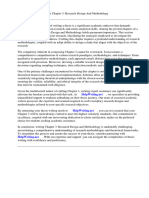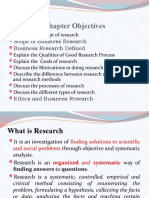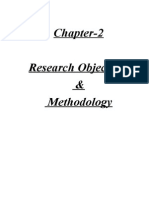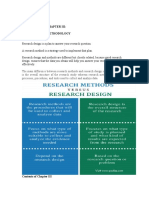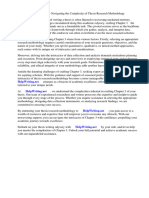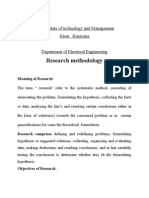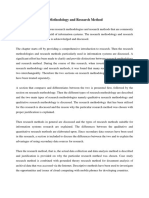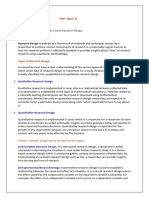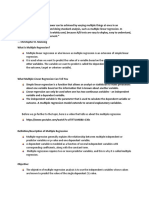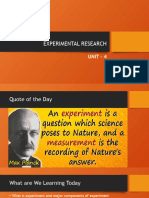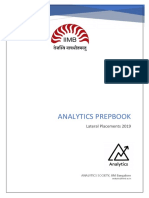Mb0050 SLM Unit03
Mb0050 SLM Unit03
Uploaded by
Jignesh PatelCopyright:
Available Formats
Mb0050 SLM Unit03
Mb0050 SLM Unit03
Uploaded by
Jignesh PatelOriginal Description:
Original Title
Copyright
Available Formats
Share this document
Did you find this document useful?
Is this content inappropriate?
Copyright:
Available Formats
Mb0050 SLM Unit03
Mb0050 SLM Unit03
Uploaded by
Jignesh PatelCopyright:
Available Formats
Research Methodology
Unit 3
Unit 3
Research Designs
Structure
3.1 Introduction
Objectives
3.2 Nature and Classification of Research Designs
3.3 Exploratory Research Designs
Secondary Resource Analysis
Case Study Method
Expert Opinion Survey
Focus Group Discussions
3.4 Descriptive Research Designs
Cross-sectional Studies
Longitudinal Studies
3.5
3.6
3.7
3.8
3.9
3.10
3.11
3.12
Experimental Designs
Errors affecting Research Design
Case Study
Summary
Glossary
Terminal Questions
Answers
References
3.1 Introduction
In the last unit, we studied the defining of the research problem and the
formulation of the research hypothesis. However, in research, it is not enough
to define the problem formulate the hypotheses. It has been found by research
scholars and managers alike that most research studies do not result in any
significant findings because of a faulty research design. Most researchers feel
that once the problem is defined and hypotheses are made, one can go ahead
and collect the data on a specified group, or sample, and then analyse it using
statistical tests. However, unless the the formulated research problem and the
study hypotheses is tested through a well defined plan, answers are going to be
based on hit and trial rather than any sound logic.
The design approach available to the researcher are many and will depend
on whether the study is of descriptive or conclusive nature. The designs range
from very simple, loosely structured to highly scientific experimentation. In this
unit, we will study the complete choice of designs, along with detailed reasoning
Sikkim Manipal University
Page No. 49
Research Methodology
Unit 3
on which design should be used under what conditions. Just as experiments in
science, in business research also there are chances of error and this needs to
be understood and controlled for more accurate results for the decision maker.
Objectives
After studying this unit, you should be able to:
describe the nature of research designs.
explain exploratory research designs.
discuss the designs used for descriptive studies.
describe the range of experimental designs available.
identify and control the errors in research designs.
3.2 The Nature and Classification of Research Designs
Once you have established the what of the study, i.e., the research problem,
the next step is the how of the study, which specifies the method of achieving
the research objectives. In other words, this is the research design.
Green et al. (2008) defines research design as the specification of methods
and procedures for acquiring the information needed. It is the overall operational
pattern or framework of the project that stipulates what information is to be
collected from which sources by what procedures. If it is a good design, it will
ensure that the information obtained is relevant to the research questions and
that it was collected by objective and economical procedures.
Thyer (1993) states that, A traditional research design is a blueprint or
detailed plan for how a research study is to be completedoperationalizing
variables so they can be measured, selecting a sample of interest to study,
collecting data to be used as a basis for testing hypotheses, and analysing the
results. Sellitz et al. (1962) state that, A research design is the arrangement of
conditions for collection and analysis of data in a manner that aims to combine
relevance to the research purpose with economy in procedure.
One of the most comprehensive and holistic definition has been given by
Kerlinger (1995). He refers to a research design as, .. a plan, structure and
strategy of investigation so conceived as to obtain answers to research questions
or problems. The plan is the complete scheme or programme of the research.
It includes an outline of what the investigator will do from writing the hypotheses
and their operational implications to the final analysis of data.
Sikkim Manipal University
Page No. 50
Research Methodology
Unit 3
Thus, the formulated design must ensure three basic principles:
(a) Convert the research question and the stated assumptions/hypotheses
into variables that can be measured.
(b) Specify the process to complete the above task.
(c) Specify the control mechanism(s) to follow so that the effect of other
variables that could have an effect on the outcome of the study have
been controlled.
At this stage, one needs to understand the difference between research
design and research method. While the design is the specific framework that
has been created to seek answers to the research question, the research method
is the technique to collect the information required to answer the research
problem, given the created framework.Thus, research designs have a critical
and directive role to play in the research process. The execution details of the
research question to be investigated are referred to as the research design.
Statistical
Designs
Experimental
Designs
QuasiExperimental
Designs
PreExperimental
Designs
Descriptive
Research
Exploratory
Research
Statistical Analysis
The researcher has a number of designs available to him for investigating
the research objectives. The classification that is universally followed is the one
based upon the objective or the purpose of the study. A simple classification
that is based upon the research needs ranging from simple and loosely structured
to the specific and more formally structured. The best way is to view the designs
on a continuum as shown in Figure 3.1. Hence, in case the research objective
Degree of Structure
Figure 3.1 Research DesignsA Continuous Process
Sikkim Manipal University
Page No. 51
Research Methodology
Unit 3
is diffused and requires a refinement, one uses the exploratory design, and this
might lead to the slightly more concrete descriptive designhere one describes
all the aspects of the construct and concepts under study. This leads to a more
structured and controlled experimental research design.
Figure 3.1 illustrates research designs as a continuous process.
Self-Assessment Questions
1. The execution details of the research question to be investigated are
referred to as the _________.
2. Research designs come __________ the problem formulation stage.
3. Researcher design is the same as research method. (True/false)
4. The formulated design must ensure:
(a) Converting the research question and the hypotheses into
measurable variables
(b) Specifying the process to complete the above task
(c) Specifying the control mechanism(s)
(d) All the above
3.3 Exploratory Research Designs
Exploratory designs, as stated earlier, are the simplest and most loosely
structured designs. As the name suggests, the basic objective of the study is to
explore and obtain clarity about the problem situation. It is flexible in its approach
and mostly involves a qualitative investigation. The sample size is not strictly
representative and at times it might only involve unstructured interviews with a
couple of subject experts. The essential purpose of the study is to:
Define and understand the research problem to be investigated.
Explore and evaluate the diverse and multiple research opportunities.
Assist in the development and formulation of the research hypotheses.
Define the variables and constructs under study.
Identify the possible nature of relationships that might exist between the
variables under study.
Explore the external factors and variables that might impact the research.
Sikkim Manipal University
Page No. 52
Research Methodology
Unit 3
For example, a university professor might decide to do an exploratory
analysis of the new channels of distribution that are being used by the marketers
to promote and sell products and services. To do this, a structured and defined
methodology might not be essential as the basic objective is to understand how
to teach this to students of marketing. The researcher can make use of different
methods and techniques in an exploratory research- like secondary data sources,
unstructured or structured observations, expert interviews and focus group
discussions with the concerned respondent group. Here, we will discuss them
in brief in the light of their use in exploratory research.
3.3.1 Secondary Resource Analysis
Secondary sources of data, as the name suggests, are data in terms of the
details of previously collected findings in facts and figureswhich have been
authenticated and published. It is a fast and inexpensive way of collecting
information. The past details can sometimes point out to the researcher that his
proposed research is redundant and has already been established earlier.
Secondly, the researcher might find that a small but significant aspect of the
concept has not been addressed and should be studied. For example, a marketer
might have extensively studied the potential of the different channels of
communication for promoting a home maintenance service in Greater Mumbai.
However, there is no impact of any mix that he has tested. An anthropologist
research associate, on going through the findings, postulated the need for
studying the potential of WOM (word of mouth) in a close-knit and predominantly
Parsi colony where this might be the most effective culture-dependent technique
that would work. Thus, such insights might provide leads for carrying out an
experimental and conclusive research subsequently.
Another valuable secondary resource is the compiled and readily available
databases of the entire industry, business or construct. These might be available
on free and public domains or through a structured acquisition process and
cost. These are both government and non-government publications. Based on
the resources and the level of accuracy required, the researcher might decide
to make use of them.
3.2.2 Case Study Method
Another way of conducting an exploratory research is the case study method.
This requires an in-depth study and is focused on a single unit of analysis. This
unit could be an employee or a customer; an organization or a complete country
analysis. They are by their nature, generally, post-hoc studies and report those
Sikkim Manipal University
Page No. 53
Research Methodology
Unit 3
incidences which might have occurred earlier. The scenario is reproduced based
upon the secondary information and a primary interview/discussion with those
involved in the occurrence. Thus, there might be an element of bias as the data,
in most cases, becomes a judgemental analysis rather than a simple recounting
of events.
For example, BCA Corporation wants to implement a performance
appraisal system in the organization and is debating between the merits of a
traditional appraisal system and a 360 appraisal system. For a historical
understanding of the two techniques, the HR director makes use of books on
the subject. However, for better understanding, he should do an in-depth case
accounting of Allied Association which had implemented traditional appraisal
formats, and Surakhsha International which uses 360 appraisal systems. Thus,
the two exploratory researches carried out were sufficient to arrive at a decision
in terms of what would be best for the organization.
3.3.3 Expert Opinion Survey
At times, there might be a situation when the topic of a research is such that
there is no previous information available on it. In these cases, it is advisable to
seek help from experts who might be able to provide some valuable insights
based upon their experience in the field or with the concept. This approach of
collecting particulars from significant and knowledgeable people is referred to
as the expert opinion survey. This methodology might be formal and structured
and is useful when authenticated or supported by a secondary/primary research
or it might be fluid and unstructured and might require an in-depth interviewing
of the expert. For example, the evaluation of the merit of marketing organic
food products in the domestic Indian market cannot be done with the help of
secondary data as no such structured data sources exist. In this case the following
can be contacted:
Doctors and dieticians as experts would be able to provide information
whether consumers would eat organic food products as a healthier
alternative.
Chefs who are experimental and would like to look at providing better
value to their clients.
Retailers who like to sell contemporary new products.
These could be useful in measuring the viability of the proposed plan.
Discussions with knowledgeable people may reveal some information regarding
who might be considered as potential consumers. Secondly, the question whether
Sikkim Manipal University
Page No. 54
Research Methodology
Unit 3
a healthy proposition or a lifestyle proposition would work better to capture the
targeted consumers needs to be examined.Thus, this method can play a
directional role in shaping the research study.
3.3.4 Focus Group Discussions
Another way to conduct a exploratory analysis is carry out discussions with
individuals associated with the problem under study. This technique, though
originally from sociology, is actively used in business research. In a typical focus
group, there is a carefully selected small set of individuals representative of the
larger respondent population under study. It is called a focus group as the
selected members discuss the concerned topic for the duration of 90 minutes
to, sometimes, two hours. Usually the group is made up of six to ten individuals.
The number thus stated is because less than six would not be able to throw
enough perspectives for the discussion and there might emerge a one-sided
discussion on the topic. On the other hand, more than ten might lead to more
confusion rather than any fruitful discussion and that would be unwieldy to
manage. Generally, these discussions are carried out in neutral settings by a
trained observer, also referred to as the moderator. The moderator, in most
cases, does not participate in the discussion. His prime objective is to manage
a relatively non-structured and informal discussion. He initiates the process
and then maneuvers it to steer it only to the desired information needs.
Sometimes, there is more than one observer to record the verbal and nonverbal content of the discussion. The conduction and recording of the dialogue
requires considerable skill and behavioural understanding and the management
of group dynamics. In the organic food product study, the focus group discussions
were carried out with the typical consumers/buyers of grocery products. The
objective was to establish the level of awareness about health hazards,
environmental concerns and awareness of organic food products. A series of
such focus group discussions carried out across four metrosDelhi, Mumbai,
Bengaluru and Hyderabadrevealed that even though the new age consumer
was concerned about health, the awareness about organic products varied from
extremely low to non-existent. (This study was carried out in the year 200405
by one of the authors for an NGO located in Delhi).
Self-Assessment Questions
5. Previously collected findings in facts and figures which have been
authenticated and published are referred to as ___________.
Sikkim Manipal University
Page No. 55
Research Methodology
Unit 3
6. A carefully selected small set of individuals representative of the larger
respondent population under study is called a _________.
7. The case study method is generally focused on a single unit of analysis.
(True/False)
8. Expert opinion survey and respondent group discussions together form a
two-tiered research design. (True/False)
9. A research study that tracks the profile of a typical social networking user
is an example of an exploratory research design. (True/False)
3.4 Descriptive Research Designs
As the name implies, the objective of descriptive research studies is to provide
a comprehensive and detailed explanation of the phenomena under study. The
intended objective might be to give a detailed sketch or profile of the respondent
population being studied. For example, to design an advertising and sales
promotion campaign for high-end watches, a marketer would require a holistic
profile of the population that buys such luxury products. Thus a descriptive
study, (which generates data on who, what, when, where, why and how of
luxury accessory brand purchase) would be the design necessary to fulfill the
research objectives.
Descriptive research thus are conclusive studies. However, they lack the
precision and accuracy of experimental designs, yet it lends itself to a wide
range of situations and is more frequently used in business research. Based on
the time period of the collection of the research information, descriptive research
is further subdivided into two categories: cross-sectional studies and longitudinal
studies.
3.4.1 Cross-sectional Studies
As the name suggests, cross-sectional studies involve a slice of the population.
Just as in scientific experiments one takes a cross-section of the leaf or the
cheek cells to study the cell structure under the microscope, similarly one takes
a current subdivision of the population and studies the nature of the relevant
variables being investigated.
There are two essential characteristics of cross-sectional studies:
The cross-sectional study is carried out at a single moment in time and
thus the applicability is most relevant for a specific period. For example,
one cross-sectional study was conducted in 2002 to study the attitude of
Sikkim Manipal University
Page No. 56
Research Methodology
Unit 3
Americans towards Asian-Americans, after the 9/11 terrorist attack. This
revealed the mistrust towards Asians. Another cross-sectional study
conducted in 2012 to study the attitude of Americans towards AsianAmericans revealed more acceptance and less mistrust. Thus the crosssectional studies cannot be used interchangeably. .
Secondly, these studies are carried out on a section of respondents from
the population units under study (e.g., organizational employees, voters,
consumers, industry sectors). This sample is under consideration and
under investigation only for the time coordinate of the study.
There are also situations in which the population being studied is not of a
homogeneous nature but composed of different groups. Thus it becomes
essential to study the sub-segments independently. This variation of the design
is termed as multiple cross-sectional studies. Usually this multi-sample analysis
is carried out at the same moment in time. However, there might be instances
when the data is obtained from different samples at different time intervals and
then they are compared. Cohort analysis is the name given to such crosssectional surveys conducted on different sample groups at different time intervals.
Cohorts are essentially groups of people who share a time zone or have
experienced an event that took place at a particular time period. For example,
in the post-9/11 cross-sectional study done in 2002, we study and compare the
attitudes of middle-aged Americans versus teenaged Americans towards AsianAmericans. These two American groups are separate cohorts and this would be
a cohort analysis. Thus the teenage American is one cohort and the middleaged cohort is separate and thinks differently.
The technique is especially useful in predicting election results, cohorts
of malesfemales, different religious sects, urbanrural or region-wise cohorts
are studied by leading opinion poll experts like Nielsen, Gallup and others. Thus,
Cross-sectionals studies are extremely useful to study current patterns of
behaviour or opinion.
3.4.2 Longitudinal Studies
A single sample of the identified population that is studied over a longer period
of time is termed as a longitudinal study design. A panel of consumers specifically
chosen to study their grocery purchase pattern is an example of a longitudinal
design. There are certain distinguishing features of the same:
The study involves the selection of a representative panel, or a group of
individuals that typically represent the population under study.
Sikkim Manipal University
Page No. 57
Research Methodology
Unit 3
The second feature involves the repeated measurement of the group
over fixed intervals of time. This measurement is specifically made for
the variables under study.
A distinguishing and mandatory feature of the design is that once the
sample is selected, it needs to stay constant over the period of the study.
That means the number of panel members has to be the same. Thus, in
case a panel member due to some reason leaves the panel, it is critical to
replace him/her with a representative member from the population under
study.
Longitudinal study using the same section of respondents thus provides
more accurate data than one using a series of different samples. These kinds
of panels are defined as true panels and the ones using a different group every
time are called omnibus panels. The advantages of a true panel are that it has
a more committed sample group that is likely to tolerate extended or long data
collecting sessions. Secondly, the profile information is a one-time task and
need not be collected every time. Thus, a useful respondent time can be spent
on collecting some research-specific information.
However, the problem is getting a committed group of people for the entire
study period. Secondly, there is an element of mortality and attrition where the
members of the panel might leave midway and the replaced new recruits might
be vastly different and could skew the results in an absolutely different direction.
A third disadvantage is the highly structured study situation which might be
responsible for a consistent and structured behaviour, which might not be the
case in the real or field conditions.
Self-Assessment Questions
10. If one wants to assess changes in investment behaviour of general public
over time, the best design available to the researcher is a longitudinal
design. (True/False)
11. A study to analyse the profile of the supporters of Anna Hazare would
need a cross-sectional research design. (True/False)
12. Married couples are the unit of analysis in a cohort analysis. (True/False)
13. Different groups of people tested over a single stretch of time is a special
characteristic of a longitudinal design. (True/False)
Sikkim Manipal University
Page No. 58
Research Methodology
Unit 3
14. The research variable in a longitudinal research design is studied over
fixed intervals in time. (True/False)
15. Descriptive designs do not require any quantitative statistical analysis.
(True/False)
3.5 Experimental Designs
Experimental designs are conducted to infer causality. In an experiment, a
researcher actively manipulates one or more causal variables and measures
their effects on the dependent variables of interest. Since any changes in the
dependent variable may be caused by a number of other variables, the
relationship between cause and effect often tends to be probabilistic in nature.
It is virtually impossible to prove a causality. One can only infer a cause-andeffect relationship.
The necessary conditions for making causal inferences are: (i) concomitant
variation, (ii) time order of occurrence of variables and (iii) absence of other
possible causal factors. The first condition implies that cause and effect variables
should have a high correlation. The second condition means that causal variable
must occur prior to or simultaneously with the effect variable. The third condition
means that all other variable except the one whose influence we are trying to
study should be absent or kept constant.
There are two conditions that should be satisfied while conducting an experiment.
These are:
(i) Internal validity: Internal validity tries to examine whether the observed
effect on a dependent variable is actually caused by the treatments
(independent variables) in question. For an experiment to be possessing
internal validity, all the other causal factors except the one whose influence
is being examined should be absent. Control of extraneous variables is a
necessary condition for inferring causality. Without internal validity, the
experiment gets confounded.
(ii) External validity: External validity refers to the generalization of the results
of an experiment. The concern is whether the result of an experiment can
be generalized beyond the experimental situations. If it is possible to
generalize the results, then to what population, settings, times, independent
variables and the dependent variables can the results be projected. It is
desired to have an experiment that is valid both internally and externally.
Sikkim Manipal University
Page No. 59
Research Methodology
Unit 3
However, in reality, a researcher might have to make a trade-off between
one type of validity for another. To remove the influence of an extraneous
variable, a researcher may set up an experiment with artificial setting,
thereby increasing its internal validity. However, in the process the external
validity will be reduced.
There are four types of experimental designs. These are explained below:
1. Pre-experimental designs: There are three designs under this one
short case study where observation is taken after the application of
treatment, one group pre test-post test design where one observation is
taken prior to the application of treatment and the other one after the
application of treatment, and static group comparison, where there are
two groups experimental group and control group. The experiment group
is subjected to treatment and a post test measurement is taken. In the
control group measurement is taken at the time when it was done for
experimental group. These do not make use of any randomization
procedures to control the extraneous variables. Therefore, the internal
validity of such designs is questionable.
2. Quasi-experimental designs: In these designs the researcher can control
when measurements are taken and on whom they are taken. However,
this design lacks complete control of scheduling of treatment and also
lacks the ability to randomize test units exposure to treatments. As the
experimental control is lacking, the possibility of getting confounded results
is very high. Therefore, the researchers should be aware of what variables
are not controlled and the effects of such variables should be incorporated
into the findings.
3. True experimental designs: In these designs, researchers can randomly
assign test units and treatments to an experimental group. Here, the
researcher is able to eliminate the effect of extraneous variables from
both the experimental and control group. Randomization procedure allows
the researcher the use of statistical techniques for analysing the
experimental results.
4. Statistical designs: These designs allow for statistical control and analysis
of external variables. The main advantages of statistical design are the
following:
The effect of more than one level of independent variable on the
dependent variable can be manipulated.
The effect of more than one independent variable can be examined.
The effect of specific extraneous variable can be controlled.
Sikkim Manipal University
Page No. 60
Research Methodology
Unit 3
Statistial design includes the following designs:
(i) Completely randomized design: This design is used when a
researcher is investigating the effect of one independent variable on
the dependent variable. The independent variable is required to be
measured in nominal scale i.e. it should have a number of categories.
Each of the categories of the independent variable is considered as
the treatment. The basic assumption of this design is that there are
no differences in the test units. All the test units are treated alike and
randomly assigned to the test groups. This means that there are no
extraneous variables that could influence the outcome.
Suppose we know that the sales of a product is influenced by the
price level. In this case, sales are a dependent variable and the
price is the independent variable. Let there be three levels of price,
namely, low, medium and high. We wish to determine the most
effective price level i.e. at which price level the sale is highest. Here,
the test units are the stores which are randomly assigned to the
three treatment level. The average sales for each price level is
computed and examined to see whether there is any significant
difference in the sale at various price levels. The statistical technique
to test for such a difference is called analysis of variance (ANOVA).
The main limitation of completely randomized designs is that it does
not take into account the effect of extraneous variables on the
dependent variable. The possible extraneous variables in the present
example could be the size of the store, the competitors price and
price of the substitute product in question. This design assumes
that all the extraneous factors have the same influence on all the
test units which may not be true in reality. This design is very simple
and inexpensive to conduct.
(ii) Randomized block design: As discussed, the main limitation of the
completely randomized design is that all extraneous variables were
assumed to be constant over all the treatment groups. This may not
be true. There may be extraneous variables influencing the
dependent variable. In the randomized block design it is possible to
separate the influence of one extraneous variable on a particular
dependent variable, thereby providing a clear picture of the impact
of treatment on test units.
In the example considered in the completely randomized design,
the price level (low, medium and high) was considered as an
Sikkim Manipal University
Page No. 61
Research Methodology
Unit 3
independent variable and all the test units (stores) were assumed to
be more or less equal. However, all stores may not be of the same
size and, therefore, can be classified as small, medium and large
size stores. In this design, the extraneous variable, like the size of
the store could be treated as different blocks. Now the treatments
are randomly assigned to the blocks in such a way so that each
treatment appears in each block at least once. The purpose of forming
these blocks is that it is hoped that the scores of the test units within
each block would be more or less homogeneous when the treatment
is absent. What is assumed here is that block (size of the store) is
correlated with the dependent variable (sales). It may be noted that
blocking is done prior to the application of the treatment.
In this experiment one might randomly assign 12 small-sized stores
to three price levels in such a way that there are four stores for each
of the three price levels. Similarly, 12 medium-sized stores and
12 large-sized stores may be randomly assigned to three price levels.
Now the technique of analysis of variance could be employed to
analyse the effect of treatment on the dependent variable and
to separate out the influence of extraneous variable (size of store)
from the experiment.
(iii) Factorial design: A factorial design may be employed to measure
the effect of two or more independent variables at various levels.
The factorial designs allow for interaction between the variables. An
interaction is said to take place when the simultaneous effect of two
or more variables is different from the sum of their individual effects.
An individual may have a high preference for mangoes and may
also like ice-cream, which does not mean that he would like mango
ice cream, leading to an interaction.
The sales of a product may be influenced by two factors, namely,
price level and store size. There may be three levels of pricelow
(A1), medium (A2) and high (A3). The store size could be categorized
into small (B1) and big (B2). This could be conceptualized as a twofactor design with information reported in the form of a table. In the
table, each level of one factor may be presented as a row and each
level of another variable would be presented as a column. This
example could be summarized in the form of a table having three
rows and two columns. This would require 3 2 = 6 cells. Therefore,
Sikkim Manipal University
Page No. 62
Research Methodology
Unit 3
six different levels of treatment combinations would be produced
each with a specific level of price and store size. The respondents
would be randomly selected and randomly assigned to the six cells.
The tabular presentation of 3 2 factorial design is given in
Table 3.1.
Table 3.1 3 2 Factorial Design for
Price Level and Store Size
Store
Price
Small (B1) Big (B2)
Low Level (A1)
A1B1
A1B2
Medium Level (A2)
A2B1
A2B2
High Level (A3)
A3B1
A3B2
Respondents in each cell receive a specified treatment combination.
For example, respondents in the upper left hand corner cell would
face small level of price and small store. Similarly, the respondents
in the lower right hand corner cell will be subjected to both high price
level and big store.
The main advantages of factorial design are:
It is possible to measure the main effects and interaction effect
of two or more independent variables at various levels.
It allows a saving of time and effort because all observations
are employed to study the effects of each factor.
The conclusion reached using factorial design has broader
applications as each factor is studied with different combinations
of other factors.
The limitation of this design is that the number of combinations
(number of cells) increases with increased number of factors and
levels. However, a fractional factorial design could be used if interest
is in studying only a few of the interactions or main effects.
Activity 1
A baker wants to decide which colour of wrapper (yellow, red and green) it
should have on his multigrain bread. If you were contacted for advice, what
steps would you follow to recommend him a particular colour?
Sikkim Manipal University
Page No. 63
Research Methodology
Unit 3
Self-Assessment Questions
16. _________ validity refers to generalization of the sample results to that
of population.
17. Test units are selected at random in quasi-experimental design. (True/
False)
18. There cannot be more than two independent variables in a factorial
experiment. (True/False)
3.6 Errors Affecting Research Design
We have discussed three types of research designs, namely, exploratory,
descriptive and experimental. All of these have some scope of error. There
could be various sources of errors in research design.
Exploratory research is conducted using focus group discussion,
secondary data, analysis of case study and expert opinion survey. It is quite
likely that members of the focus group have not been selected properly.
Secondary data may not be free from errors (in fact, one needs to evaluate the
methodology used in collecting such a data). Also, the experts chosen for the
survey may not be experts in the field. As a matter of fact, getting an expert is
very difficult task. All these factors could lead to errors in the exploratory design.
In the descriptive design, the purpose is to describe a phenomenon. For
this one could use a structured questionnaire. It could always a happen that the
respondents do not give correct responses to some of the questions, thereby
resulting in wrong information.
In the true experimental design and statistical design, the respondents
are selected at random which may not be the case in real life. Many a times, in
actual business situation, the value judgements play very important role in
selecting the respondents. Further, there can always be errors in observations.
Activity 2
Choose a company that is facing a high turnover of employees. Conduct a
focus group discussion to get an insight into the problems. You might find
that some of the members of the group are not participating in the discussion
at all. At the end of the focus group discussion, talk to these members to
identify the possible causes of their non-participation. These could be the
possible causes of errors in the study.
Sikkim Manipal University
Page No. 64
Research Methodology
Unit 3
Self-Assessment Questions
19. There is no possiblity of error in true experimental research design. (True/
False)
20. In the true experimental design and statistical design, the respondents
are selected at random which may not be the case in real life. (True/False)
3.7 Case Study
Keep Your City Clean: Environmental Concerns
Over the last decade, recycling of household waste has become an
extremely important behaviour across the nations. However, in Asian
countries this fluctuates from one country to the other. China is the leader
amongst waste management while India, an equally large country, still has
a long way to go. Though these are essentially policy driven or community
driven initiatives, there are a number of attitudinal and motivational barriers
to recycling, acting at an individual level.
Punita Nagarajan, a business studies graduate with a keen interest in
environmental issues, read about this in a special report in the newspaper.
She recognized a potential business opportunity. It seemed obvious to her
that there was scope for a potentially lucrative business related to some
aspect of household recycling. All she had to do was work out some way of
alleviating the inconvenience people associated with recycling.
Punita decided that a door-to-door recycling service may be a profitable
way to get people to recycle. She believed that households would be willing
to pay a small fee to have their waste collected on a weekly basis, from
outside their home. Punita discussed this idea with a few friends, who were
very receptive, reinforcing Punitas views that this was indeed a good
business opportunity. However, before she developed a detailed business
plan, she decided it was necessary to confirm her thoughts and suspicions
regarding the consumers views about recycling. In particular, she needed
to check that her ideas, about convenience and recycling, were on the right
track. To do this, she decided to conduct some research into attitudes
towards household recycling.
Sikkim Manipal University
Page No. 65
Research Methodology
Unit 3
Discussion Questions
1. What is the kind of research design you would advocate here?
2. Identify your variables and the population under study.
3. Can you suggest any alternative design? Why/Why not?
[Hint: This study requires getting current opinion of the stated population
on any of the above variables. You may look at the design which tries to
seek current data.If you take attitude as an independent variable and
recycling behavior as the dependent variable then the research design would
change. Recall the design that measures the relationship between
independent and dependent variables.]
3.8 Summary
Let us recapitulate the important concepts discussed in this unit:
Research design is the blueprint or the framework for carrying out the
research study.
The researcher has a number of designs available to him for investigating
the research objectives. Based upon the objective or the purpose of the
study, research design may be exporatory, descriptive or experimental.
Exploratory designs are loosely structured and investigative in nature.
In case the hypothesis formulated is descriptive in nature, the study design
would also be descriptive. The study involves collecting the who, what,
why, where, why, when and how about the population under study.
Descriptive studies can further be divided into cross-sectional, i.e., studying
a section of the population at a single time period. In case the study is
conducted on a single population, it is called as single cross-sectional
and in case, it is done on more than one segment it is called multiple
cross-sectional designs.
Another type of descriptive desgn is the longitudinal design. Here, a
selected sample is studied at different intervals (fixed) of time to measure
the variable(s) under study.
Experimental designs are conducted to infer causality. There are four
types of experimental designs pre-experimental designs, quasiexperimental designs, true experimental designs and statistical designs
Sikkim Manipal University
Page No. 66
Research Methodology
Unit 3
3.9 Glossary
Case study method: An in-depth study of a single unit of analysis. This
could be an employee, the owner, a customer, a company or even a
country.
Cross-sectional designs: A descriptive study done on a representative
group of people at a single moment in time.
Descriptive designs: Research designs that describe in detail the
phenomena under study.
Exploratory research design: Loosely structured research design to
explore and gain clarity about the research questions.
Focus group discussion: A sociological method in which 6-10 people
discuss the topic being researched.
Judgemental analysis: Formation of a judgement based upon personal
impressions rather than facts.
Longitudinal designs: A single sample studied over a longer period of
time. There are periodic measurements done of the study variable.
Test unit: A unit on which treatment is applied.
3.10 Terminal Questions
1. How would you define research designs? What are the three principles to
be taken care of when selecting a research design?
2. What are exploratory designs? What are the methods that can be used in
an exploratory design?
3. What are descriptive designs? What are the different kinds of descriptive
designs available?
4. Distinguish between internal and external validity of the experiments.
5. Explain the four types of experimental designs.
6. Discuss the various sources of errors.
Sikkim Manipal University
Page No. 67
Research Methodology
Unit 3
3.11 Answers
Answers to Self-Assessment Questions
1. Research design
2. After
3. False
4. (d) All the above
5. Secondary data sources
6. Focus group
7. True
8. False
9. False
10. True
11. True
12. False
13. False
14. True
15. False
16. External
17. False
18. False
19. False
20. True
Answers to Terminal Questions
1. The research design is the specific framework that has been created to
seek answers to the research question. Refer to Section 3.2 for further
details.
2. Exploratory designs are the simplest and most loosely structured designs.
Refer to Section 3.3 for further details.
Sikkim Manipal University
Page No. 68
Research Methodology
Unit 3
3. The objective of descriptive research studies is to provide a comprehensive
and detailed explanation of the phenomena under study. Refer to Section
3.4 for further details.
4. Internal validity tries to examine whether the observed effect on a
dependent variable is actually caused by the treatments (independent
variables) in question, while external validity refers to the generalization
of the results of an experiment. Refer to Section 3.5 for further details.
5. There are four types of experimental designs. Refer to Section 3.5 for
further details.
6. All the research designs have some scope of error. Refer to Section 3.6
for further details.
3.12 References
1. Chawla D and Sondhi, N. (2011). Research Methodology: Concept and
Cases, New Delhi: Vikas Publishing House.
2. Green, P G, Tull, D S and Albaum G A. (2008). Research for Marketing
Decisions. 5th edn. New Delhi: Prentice Hall of India.
3. Kerlinger, F N. (1995). The Foundation of Behavioural Science. New York:
Holt, Rinehart and Winston.
Sikkim Manipal University
Page No. 69
You might also like
- Methods of Research: Simple, Short, And Straightforward Way Of Learning Methods Of ResearchFrom EverandMethods of Research: Simple, Short, And Straightforward Way Of Learning Methods Of ResearchRating: 4.5 out of 5 stars4.5/5 (6)
- Business Research Assignment 1Document9 pagesBusiness Research Assignment 1ZunairaAslamNo ratings yet
- Research 7aDocument11 pagesResearch 7ashubey kayuyuNo ratings yet
- CHAPTER FOUR - Research Design: Learning ObjectivesDocument13 pagesCHAPTER FOUR - Research Design: Learning ObjectivesHayelom Tadesse GebreNo ratings yet
- Assignment Reaserarch MethadologyDocument7 pagesAssignment Reaserarch Methadologyhoneyverma3010No ratings yet
- Qualitative Dissertation Chapter 3Document7 pagesQualitative Dissertation Chapter 3WriteMyPaperForMoneySiouxFalls100% (2)
- Chapter 3 Thesis Sample QualitativeDocument4 pagesChapter 3 Thesis Sample Qualitativemariesmithwilmington100% (2)
- Research Methodology in Thesis Chapter 3Document7 pagesResearch Methodology in Thesis Chapter 3PaperWritingServiceCollegeUK100% (2)
- Research Methodology Lecture - 6Document14 pagesResearch Methodology Lecture - 6Tasin Safwath ChowdhuryNo ratings yet
- Research Methodology Unit 1 Ph.D. Course WorkDocument15 pagesResearch Methodology Unit 1 Ph.D. Course WorkMOHAMMAD WASEEMNo ratings yet
- Research MethodologyDocument25 pagesResearch Methodologykrrish.kalyanNo ratings yet
- Chapter 3 Thesis Research DesignDocument8 pagesChapter 3 Thesis Research DesignBuyingEssayBridgeport100% (1)
- Dissertation Chapter 3 MethodologyDocument4 pagesDissertation Chapter 3 MethodologyCustomPaperServicesUK100% (1)
- Sample of Thesis Chapter 3 MethodologyDocument6 pagesSample of Thesis Chapter 3 Methodologymariestarsnorthlasvegas100% (2)
- Research Design - by Faisal HakimzadDocument12 pagesResearch Design - by Faisal HakimzadHakimzad9001 Faisal9001No ratings yet
- Research DesignDocument4 pagesResearch DesignUmer NawazNo ratings yet
- CH 5 Research PurposeDocument5 pagesCH 5 Research Purposeyoussef waleedNo ratings yet
- Example of A Thesis Chapter 3 Research Design and MethodologyDocument5 pagesExample of A Thesis Chapter 3 Research Design and Methodologyafcnwwgnt100% (2)
- Mb0050, Research MethodologyDocument10 pagesMb0050, Research Methodologyhemant kumarNo ratings yet
- Research DesignDocument3 pagesResearch DesignM Sohail KhanNo ratings yet
- Topic 3: Research Approaches and Research Designs: Post Your Discussion in The Provided Discussion ForumDocument10 pagesTopic 3: Research Approaches and Research Designs: Post Your Discussion in The Provided Discussion ForumSimon ChegeNo ratings yet
- SMU Marketing Research Ch-3 Nidhi SharmaDocument25 pagesSMU Marketing Research Ch-3 Nidhi Sharmanidhi140286100% (1)
- How To Write Research Methodology Chapter in ThesisDocument8 pagesHow To Write Research Methodology Chapter in Thesisbsqkr4kn100% (1)
- Chapter Objectives: Scope of Business Research Business Research DefinedDocument49 pagesChapter Objectives: Scope of Business Research Business Research DefinedZena Addis Shiferaw100% (1)
- Unit IiiDocument18 pagesUnit IiiEbsa AdemeNo ratings yet
- Basic Research Method in Social ScienceDocument91 pagesBasic Research Method in Social ScienceSagar Sunuwar100% (1)
- Unit Ii (Research Methods in Business)Document14 pagesUnit Ii (Research Methods in Business)RAMESH KUMARNo ratings yet
- Dissertation Chapter 3 Research MethodologyDocument7 pagesDissertation Chapter 3 Research MethodologyBuyPapersForCollegeOnlineArlington100% (1)
- Prac2 q4 Mod4.No Answer KeyDocument47 pagesPrac2 q4 Mod4.No Answer Keyjungcolemerjerih100% (1)
- Chapter-2 Research Objectives & MethodologyDocument12 pagesChapter-2 Research Objectives & MethodologyGautamNo ratings yet
- Research Methodology NOTESDocument6 pagesResearch Methodology NOTESuzzaifmansuri786No ratings yet
- How To Write Chapter IiiDocument7 pagesHow To Write Chapter IiiJaira May BustardeNo ratings yet
- Module - 3 Research DesignDocument15 pagesModule - 3 Research DesignlucyNo ratings yet
- Module - 3 Research DesignDocument15 pagesModule - 3 Research DesignlucyNo ratings yet
- PGCRSM-01-BLOCK-03 Research Design ExperimentalDocument29 pagesPGCRSM-01-BLOCK-03 Research Design ExperimentalVijilan Parayil VijayanNo ratings yet
- UG Physiology Sem6 DSE4TDocument37 pagesUG Physiology Sem6 DSE4TBiksham JimmidiNo ratings yet
- Research Methodology 00520Document25 pagesResearch Methodology 00520Tedros BelaynehNo ratings yet
- BRM Unit-2Document16 pagesBRM Unit-2Deepa SelvamNo ratings yet
- Research DesignDocument6 pagesResearch Designashwini rotheNo ratings yet
- Research Design DefinitionDocument7 pagesResearch Design Definitionstudent0990No ratings yet
- Research Methodology Lecture PPTs Unit IIDocument57 pagesResearch Methodology Lecture PPTs Unit IIAmit KumarNo ratings yet
- Chapter 3 Thesis Research MethodologyDocument9 pagesChapter 3 Thesis Research Methodologylaurabenitezhialeah100% (2)
- Chapter 3: Formulating The Research ProblemDocument11 pagesChapter 3: Formulating The Research ProblemKei Emile DaisyNo ratings yet
- Basic Research Method in Social ScienceDocument23 pagesBasic Research Method in Social ScienceSagar SunuwarNo ratings yet
- How To Write Chapter 3 Methodology of A ThesisDocument7 pagesHow To Write Chapter 3 Methodology of A Thesisafkodkedr100% (2)
- Week 9 Lecture RMDocument2 pagesWeek 9 Lecture RMmudsarjabbar628No ratings yet
- dbb2103 Anamika1Document18 pagesdbb2103 Anamika1anamikarajendran441998No ratings yet
- Steps of Research ProcessDocument6 pagesSteps of Research ProcessJasreaNo ratings yet
- UNIT 2: Research Methods ReviewerDocument9 pagesUNIT 2: Research Methods ReviewerRhyle Cristy AbordeNo ratings yet
- Writing A Thesis Methods SectionDocument7 pagesWriting A Thesis Methods Sectionsjfgexgig100% (1)
- Chap 4Document6 pagesChap 4Milkias MuseNo ratings yet
- Chapter 3 Methodology Thesis SampleDocument4 pagesChapter 3 Methodology Thesis Samplebsqjpnxd100% (2)
- Research MethodologyDocument27 pagesResearch Methodologysoumencha50% (2)
- Lesson 4Document13 pagesLesson 4ERLINDA PALACIONo ratings yet
- Research Process - PR RESEARCHDocument4 pagesResearch Process - PR RESEARCHPratik SahaNo ratings yet
- Chapter 3 Research Methodology and ReseaDocument42 pagesChapter 3 Research Methodology and Reseamintesinot sisayNo ratings yet
- MB0050Document8 pagesMB0050Rajni KumariNo ratings yet
- Research MethodDocument12 pagesResearch MethodHakimzad9001 Faisal9001No ratings yet
- RM Unit 1 (Part 2)Document10 pagesRM Unit 1 (Part 2)anubhaviawasthi20No ratings yet
- Practical Research 2: Department of EducationDocument9 pagesPractical Research 2: Department of EducationLianne LagayanNo ratings yet
- Cvru New Guide Book 2012-13 Arts - Selected 08-01-2013Document164 pagesCvru New Guide Book 2012-13 Arts - Selected 08-01-2013Jignesh PatelNo ratings yet
- Unit 4 Primary and Secondary Data: StructureDocument28 pagesUnit 4 Primary and Secondary Data: StructureJignesh PatelNo ratings yet
- Unit 1 Software Evolution: Structure Page NoDocument41 pagesUnit 1 Software Evolution: Structure Page NoJignesh PatelNo ratings yet
- Performance Appraisals: Directors' Briefing Human Resources ManagementDocument4 pagesPerformance Appraisals: Directors' Briefing Human Resources ManagementJignesh PatelNo ratings yet
- A Globally Certified Skill Development ProgrammeDocument4 pagesA Globally Certified Skill Development ProgrammeJignesh PatelNo ratings yet
- Unit 2 Operating System: Structure Page NoDocument12 pagesUnit 2 Operating System: Structure Page NoJignesh PatelNo ratings yet
- AprilExam FinalDocument2 pagesAprilExam FinalJignesh PatelNo ratings yet
- Bca3020 Unit 11 SLMDocument22 pagesBca3020 Unit 11 SLMJignesh PatelNo ratings yet
- MCA Operating SystemDocument1 pageMCA Operating SystemJignesh PatelNo ratings yet
- Job Portal SynopsisDocument3 pagesJob Portal SynopsisJignesh PatelNo ratings yet
- Java Project Titles With AbstractsDocument302 pagesJava Project Titles With AbstractsJignesh PatelNo ratings yet
- 1396086940101Document5 pages1396086940101Jignesh PatelNo ratings yet
- MBA - Total Quality ManagementDocument40 pagesMBA - Total Quality ManagementJignesh PatelNo ratings yet
- MK0016 Advertising Management and Sales Promotion Winter 2013Document5 pagesMK0016 Advertising Management and Sales Promotion Winter 2013Jignesh PatelNo ratings yet
- Inventory ManagementDocument13 pagesInventory ManagementJignesh PatelNo ratings yet
- 20 MASTER Exercise Answers MBADocument38 pages20 MASTER Exercise Answers MBASimbarashe Stewart KamwendoNo ratings yet
- Multiple Regression Analysis: Y-InterceptDocument22 pagesMultiple Regression Analysis: Y-Interceptyoussef888 tharwatNo ratings yet
- Psychology and Marketing - 2022 - D'Ambrogio - How celebrity status and gaze direction in ads drive visual attention toDocument12 pagesPsychology and Marketing - 2022 - D'Ambrogio - How celebrity status and gaze direction in ads drive visual attention tofokorenoNo ratings yet
- EFVol 122article4Document16 pagesEFVol 122article4jzhaNo ratings yet
- Baker 1999Document17 pagesBaker 1999Hery pratama putraNo ratings yet
- GR 6Document11 pagesGR 6Kiều Anh Lê ThịNo ratings yet
- Nonlinear Least Squares Data Fitting in Excel SpreadsheetsDocument15 pagesNonlinear Least Squares Data Fitting in Excel SpreadsheetsAlbyziaNo ratings yet
- 1 - Multiple RegressionDocument8 pages1 - Multiple Regressionzeref dragneelNo ratings yet
- Mental Health Problems in College FreshmenDocument28 pagesMental Health Problems in College FreshmenPhillip MendozaNo ratings yet
- 7 Research VariablesDocument17 pages7 Research VariablesAbdi WorkinehNo ratings yet
- Supervisory Behavior Description QuestionnaireDocument139 pagesSupervisory Behavior Description QuestionnaireAnonymous j9lsM2RBaINo ratings yet
- Comparison Between Public and Private Sector in PakistanDocument39 pagesComparison Between Public and Private Sector in PakistanJeet SummerNo ratings yet
- 10 1108 - Jsbed 06 2023 0258Document24 pages10 1108 - Jsbed 06 2023 0258LeslayVelezmoroNo ratings yet
- Kripfganz Schneider 2023 Ardl Estimating Autoregressive Distributed Lag and Equilibrium Correction ModelsDocument37 pagesKripfganz Schneider 2023 Ardl Estimating Autoregressive Distributed Lag and Equilibrium Correction Modelsfinancesiba7No ratings yet
- TheImpactofTimeManagementontheStudents1-PB 2 PDFDocument8 pagesTheImpactofTimeManagementontheStudents1-PB 2 PDFKrisha LalosaNo ratings yet
- Face Mask Detection Using Deep LearningDocument31 pagesFace Mask Detection Using Deep Learningfathima thNo ratings yet
- Alishba 2Document18 pagesAlishba 2RabiaNo ratings yet
- Gold Rate PredictionDocument2 pagesGold Rate Predictionreshmakr.learnNo ratings yet
- Unit 5. Transportation Systems Planning: Civil Engineering Department 8 SemesterDocument19 pagesUnit 5. Transportation Systems Planning: Civil Engineering Department 8 SemesterBadal NayakNo ratings yet
- Grice Iwasaki AMRDocument28 pagesGrice Iwasaki AMRRafael Loaiza RamírezNo ratings yet
- 8604 Unit 4 Revised Experimental Research 1Document22 pages8604 Unit 4 Revised Experimental Research 1amirkhan30bjrNo ratings yet
- Sensitivity AnalysisDocument4 pagesSensitivity AnalysisKaleem ullahNo ratings yet
- Introduction To Science Investigatory ProjectDocument11 pagesIntroduction To Science Investigatory ProjectJoel VillegasNo ratings yet
- Decision Tree and Related Techniques For Classification in ScalationDocument12 pagesDecision Tree and Related Techniques For Classification in ScalationZazkyeyaNo ratings yet
- Intergenerational Sense of Place Among Residents of Lazi in Siquijor IslandDocument6 pagesIntergenerational Sense of Place Among Residents of Lazi in Siquijor IslandShien PGNo ratings yet
- Dellande and Nyer (2007)Document8 pagesDellande and Nyer (2007)viraggadaNo ratings yet
- CHAPTER 14 Regression AnalysisDocument69 pagesCHAPTER 14 Regression AnalysisAyushi JangpangiNo ratings yet
- Homework 1Document9 pagesHomework 1Frank GengNo ratings yet
- Bio 122 Chapter 3 Scientific MethodDocument46 pagesBio 122 Chapter 3 Scientific MethodEva NatashaNo ratings yet
- Analytics Prepbook Laterals 2019-2020Document40 pagesAnalytics Prepbook Laterals 2019-2020Surabhi Sharma100% (1)

















